26 Apr
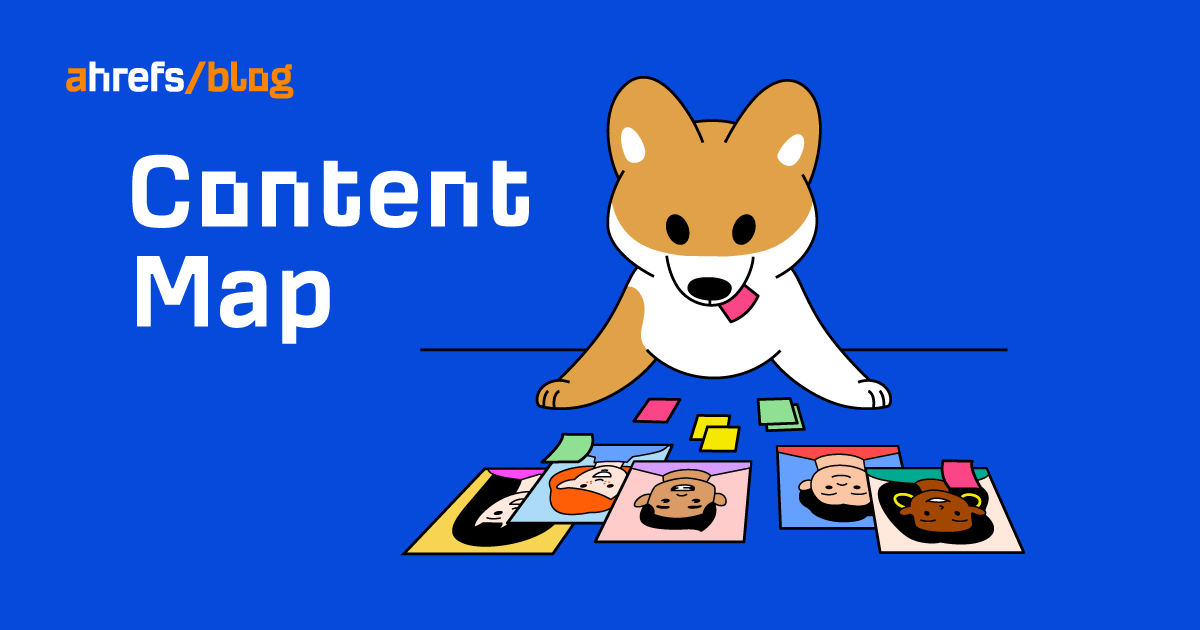
Content maps help make sure your content serves a strategic role in nurturing your audience. It’s one of the best ways to keep your content aligned with your business goals.
I’ll cover two ways of creating content maps. The traditional way and the Ahrefs way. Both are tried and tested methods, but we like ours better—and I’ll explain why. Read on to learn both methods and choose the one that better suits your needs. We’ll talk about the following:
A content map is a document that lists stages of the buyer’s journey for every buyer persona and maps them with relevant content.

Example content map (from our content template). Different pieces of content have been assigned to various buyer’s journey stages for a particular buyer persona. Feel free to take a closer look at this inside our content map template.
The main reason for creating a content map is to make sure your brand’s content is accompanying each buyer persona throughout all stages of the marketing funnel—from attracting visitors to converting them and keeping them on board.
Here’s an additional reason. A sort of byproduct of creating a content map is getting an overview of your content inventory. This can help you spot gaps and find repurposing opportunities.
Follow these three steps to create your content map and fill any gaps with new content ideas.
1. Create buyer personas
A buyer persona is a semi-fictional person who represents the common characteristics of your customers (an archetype). Here’s an example buyer persona for our product:
A buyer persona helps you visualize your customers’ buying journey, internalize who they are, and empathize with their challenges and goals.
Depending on your resources, there are two ways you can identify your customers to create a buyer persona:
- The scientific way – Talk to potential customers. This can be your leads, social media followers, or simply people you know who may be interested in your product. You may also consider using services like SurveyMonkey, UserTesting, or Remesh to reach these people.
- The educated-guess way – If for some reason you can’t talk to real people at this stage, you need to get creative. Use your competitors’ data or the industry data and “enrich” it with other sources. You may find that, for example, organic search is the #1 spending priority, according to a CMO survey.
To make your content mapping effective, you need to create a buyer persona for each type of customer. The more granular your typology is, the more customized your content. On the other hand, it will take you more time and resources to address all the personas’ goals and challenges compared to more generalized content.
Too many personas? Consider creating categories that connect personas with similar traits, e.g., business owners, in-house teams, freelancers, etc.
2. Use our template to map existing content for each persona
To make content mapping easier, I’ve prepared a simple template. (Click here to make your own editable copy in Google Sheets.)
All you need to do here is to fill in your existing content under the corresponding stage of the buyer’s journey (you can find some examples in the template). If you don’t have any content to map yet or want to start over, no worries—I’ll share some ideas to solve these issues in the next section.
As for the stages of the buyer’s journey, there are many different typologies out there. I’ve used the one from our guide to creating a winning content strategy. It may be slightly different than what you’re used to, so feel free to modify it accordingly.
If this stuff is totally new to you, don’t bother customizing those stages for now. The general idea is to create content that attracts visitors and gradually turns them into happy customers who are willing to come back to you. So here are short descriptions of the stages used in the template:
- Increase brand awareness – At this stage, the prospect is just becoming aware of their problem. They don’t know the solution yet and may not know your brand. This type of content doesn’t necessarily need to feature your product, as you’re basically trying to introduce your brand to potential customers.
- Create interest and desire – You can do so by teaching potential customers more about their problems and how your product or service can solve them.
- Nurture interest and entice the purchase – You can further educate potential customers about your product or service and why it’s the best solution for them.
- Retain customers and build brand loyalty – To do this, educate customers on how to get the most out of your product or service and clearly demonstrate its value. Additionally, in this stage, you can tackle topics that you know your customers care for but do not necessarily give you the opportunity to feature your product/service in any practical way.
As you write down your content pieces, you can come across some dilemmas.
- The content fits multiple stages – You still have to choose one. Choose the one with the most dominant use case.
- The content doesn’t fit anywhere – See if that piece of content can be updated so that you can classify it easier without losing its current value. Another scenario is that my template is too simplistic. If so, you may need to add the buyer’s journey stages.
3. Fill in any gaps in the buyer’s journey
Chances are that while making your content map, you will find gaps in your buyer’s journey: places where there is no content or not enough content to serve a given journey stage. In that case, there are basically four methods for filling those gaps with relevant content ideas.
Do keyword research
Keyword research is the process of understanding the language your target customers use when searching for your products, services, and content. It then involves analyzing, comparing, and prioritizing the best keyword opportunities for your website.
For example, we can assume that our persona, Anna Agency, needs to figure out SEO tactics for clients from different industries. Keyword research will help us discover those industries, see search demand for related topics, and quickly gauge potential traffic.
To do this, we just need a seed keyword (e.g., “seo”) to view related topics and then we can fine-tune the search using various filters.
In the example below, I’m using the “for” modifier word. I’m also including queries that have more than 200 monthly searches and excluding words that are irrelevant—all in Ahrefs’ Keywords Explorer.

We can further narrow down that list by using other filters. For example, we can filter by Keyword Difficulty (KD) to see keywords that we can potentially rank for with less effort. Or we can use the Traffic Potential (TP) filter to hide keywords with low traffic.
Then, we can generate even more keyword ideas by using other modifier keywords that signal educational intent. Here are some of these words: how, guide, resource, ideas, tips, etc.

Last but not least, Ahrefs has a separate report for all of the questions related to a given topic that people type in Google, and it’s just one click away from the report we’ve been using so far.
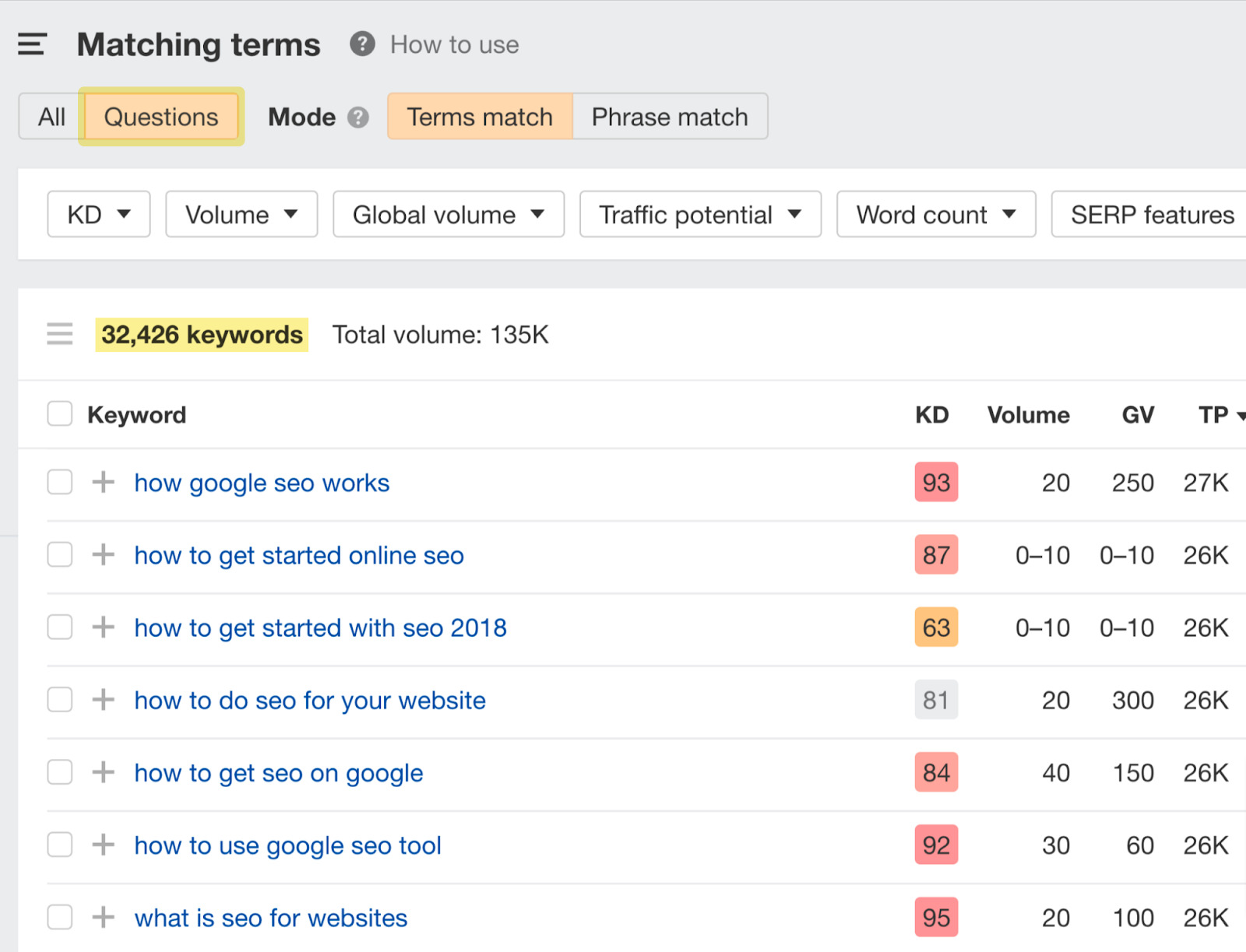
Analyze competitors
One way to draw inspiration from your competitors is to manually check their websites for topic ideas. That’s a lot of man-hours.
Here’s how you can streamline this process with Ahrefs.
First of all, start by listing your competitors and doing basic market research. You can always double-check your competitor list by plugging your URL in Ahrefs’ Site Explorer and going to the Competing Domains report.
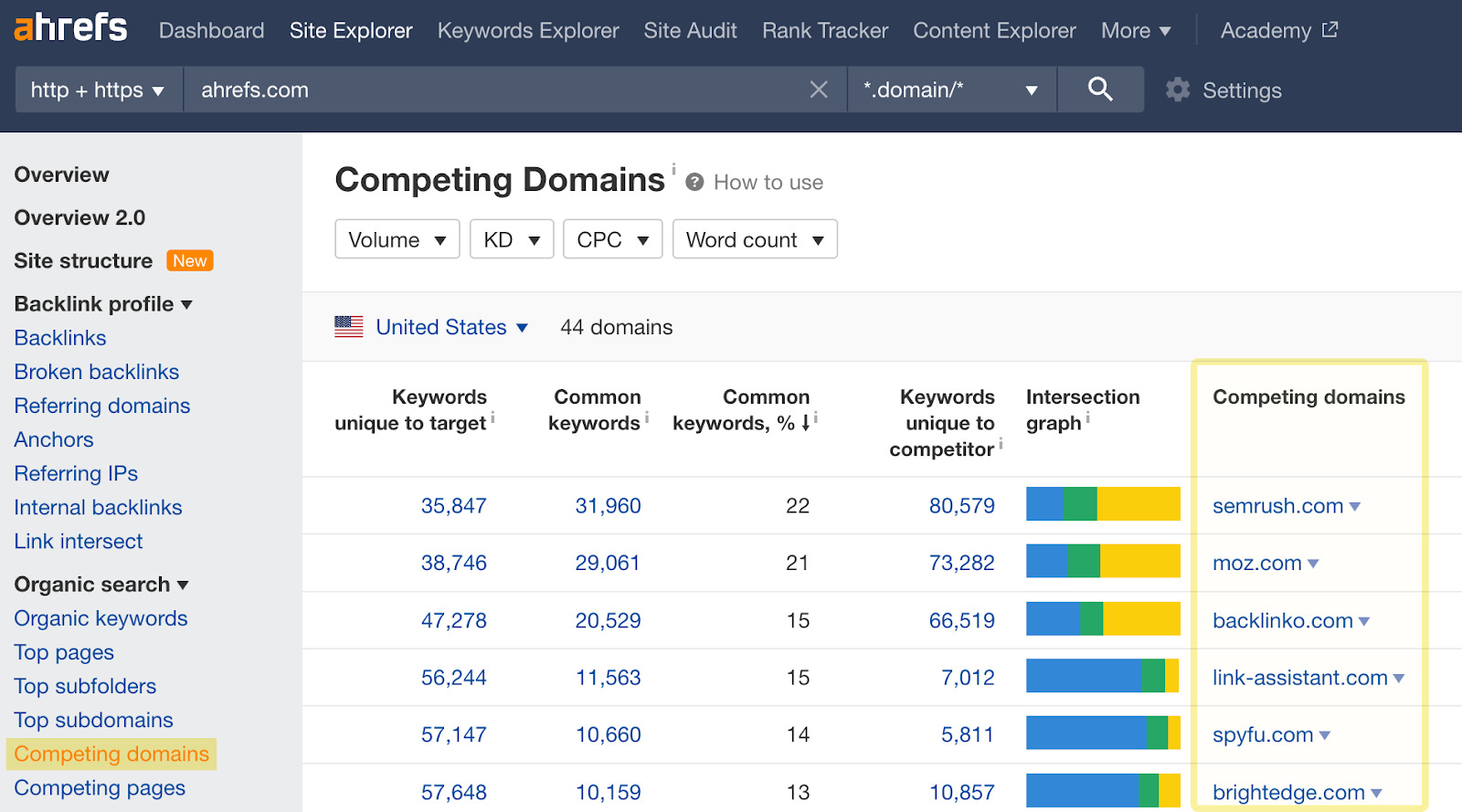
Now you can take the list of competitors to the Content Gap report to reveal the keywords that your competitors rank for but you don’t. These will be your new content opportunities. You can then filter that list to make it more manageable.
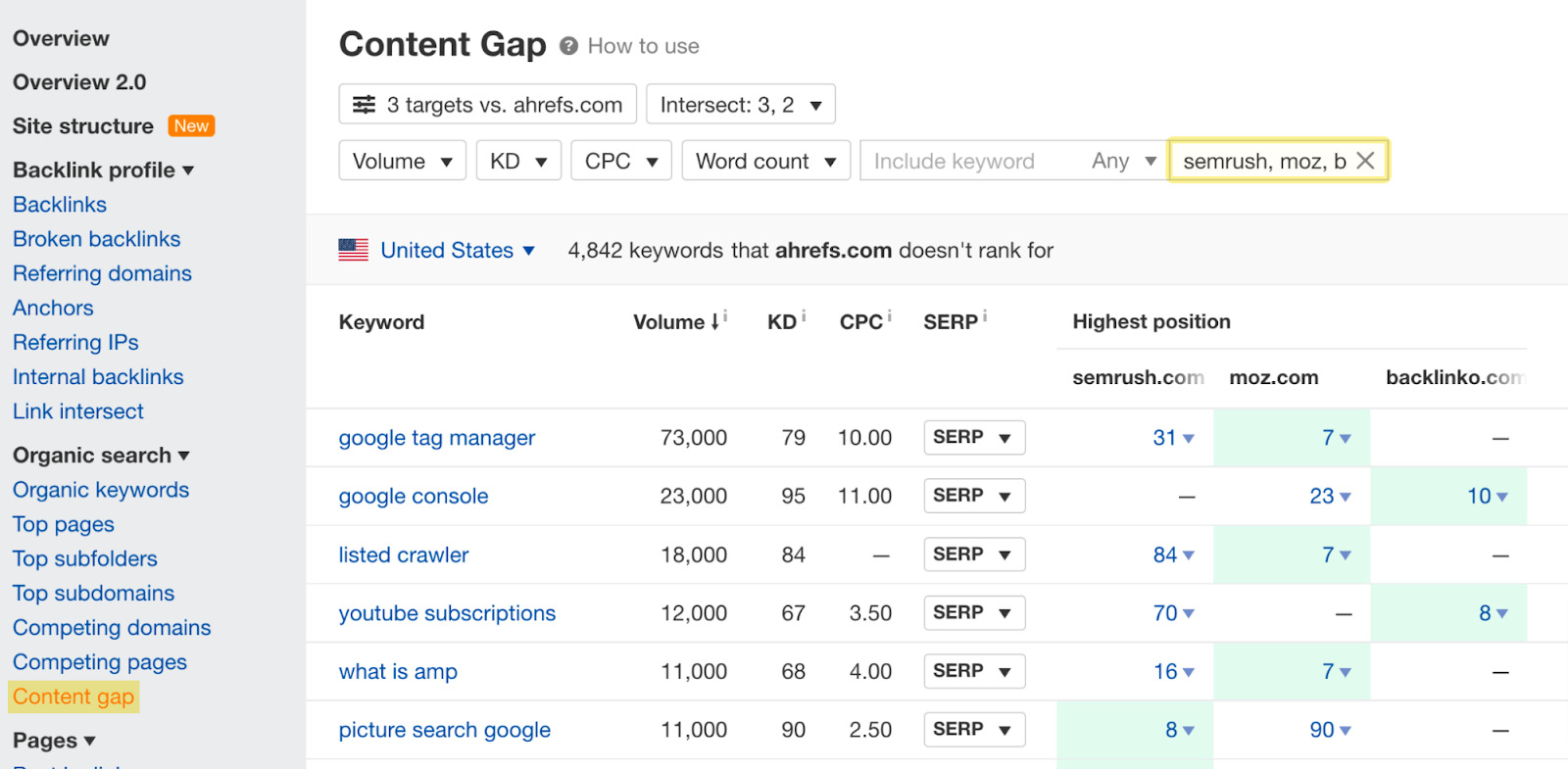
In the Content Gap report, you can filter out branded keywords for more clarity.
Additionally, you can easily discover your competitors’ best content. There are a few ways to do that, depending on your marketing objectives.
If you want to create content that is designed to rank on search engines and bring you organic traffic, try the Top pages report.

This report not only shows you the content and its traffic but also changes in traffic over time. This allows you to spot declining and trending topics.
But if it’s links that you’re after, you can use the Best by links or Best by links’ growth reports.
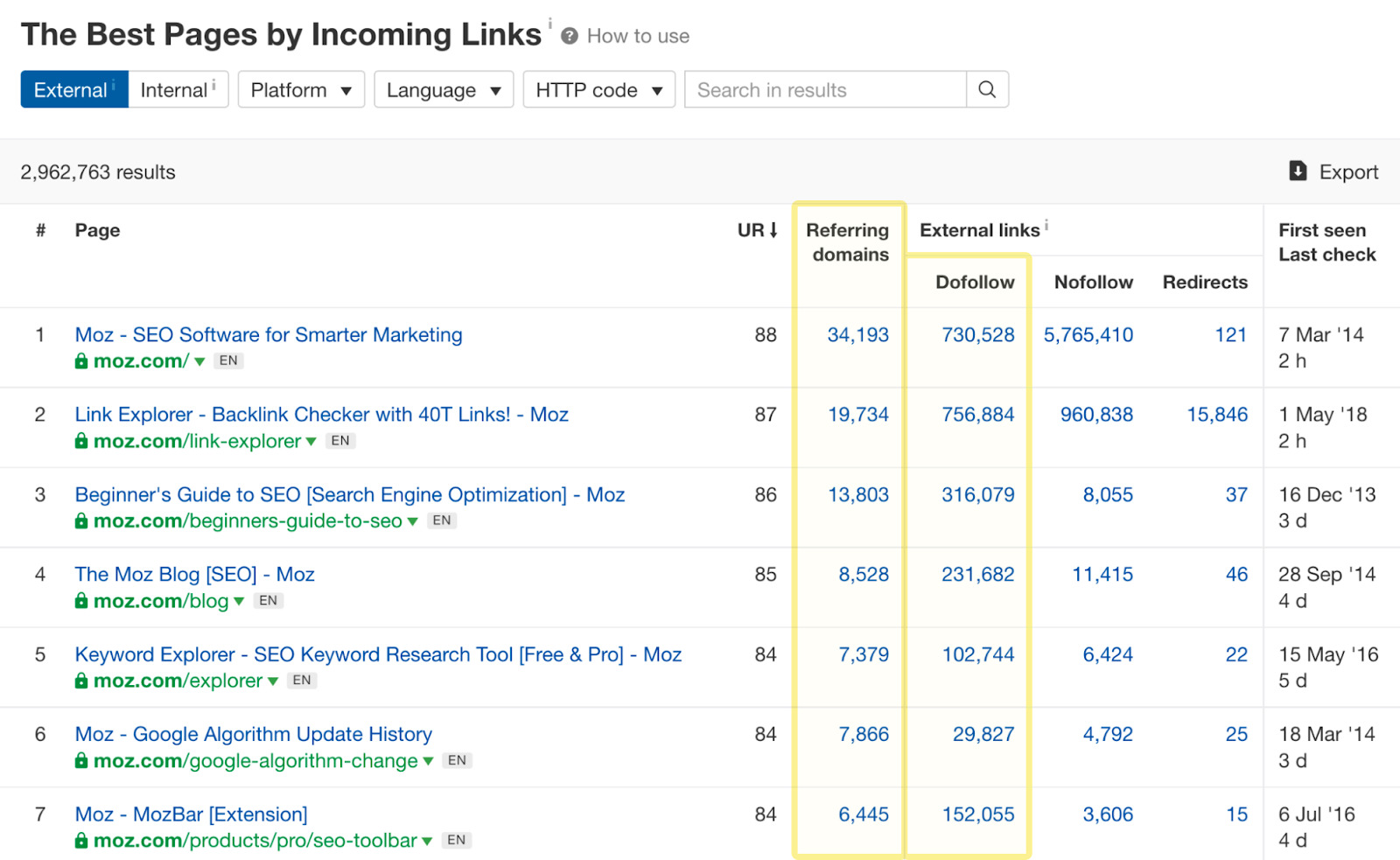
Finally, if you need social shares the most, go to our Top Content report to uncover content where your competitors got the most Twitter and Pinterest shares.
This report can also be used as a proxy for understanding what types of content resonate with your competitors’ target audiences because it also shows how many websites linked to that content and which parts were the most valuable (by viewing the anchors they linked with).
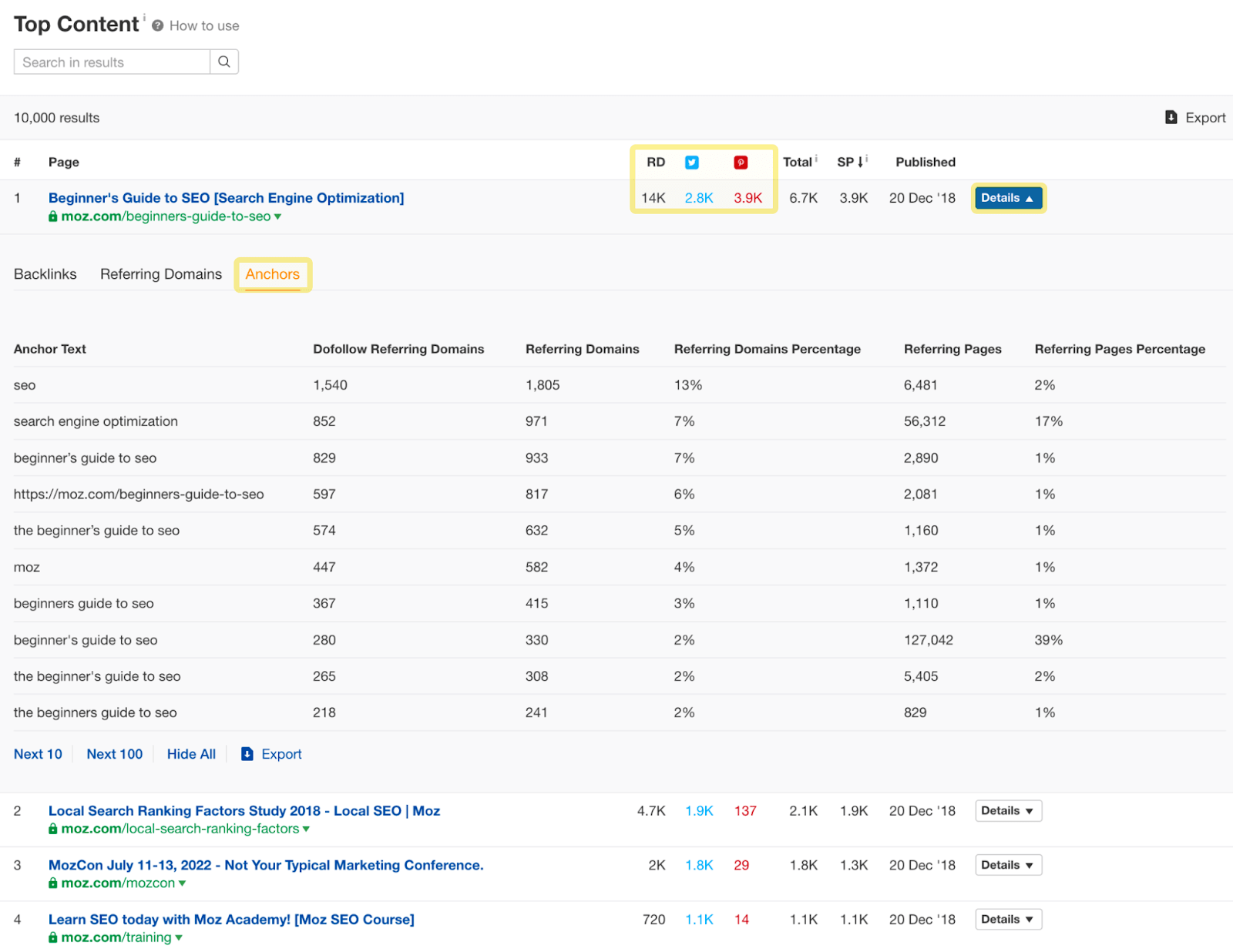
Apart from social media stats, this report offers insights into the reason why people linked to the content. You can click the “Details” button to uncover link anchors.
Study your niche
Another way of discovering relevant topics to enrich your content map is paying attention to what other people say in places where your industry and/or your target audience hangs out; for example, groups on social media, magazines, personal blogs, and communities.
A lot of the time, you will find information that overlaps with keyword research. But other times, you will come across hidden gems, such as:
- The next big thing people are talking about but no one has written a comprehensive guide for.
- Topics underserved by your competitors.
- Things your target audience wants to learn more about (and how they want to learn about said things).
- What language your target audience uses to express their goals and challenges.
For example, one of our best-performing articles, “How to Submit Your Website to Google,” was inspired by a printed magazine titled “How to set up an online business” that was found in an airport bookstore.
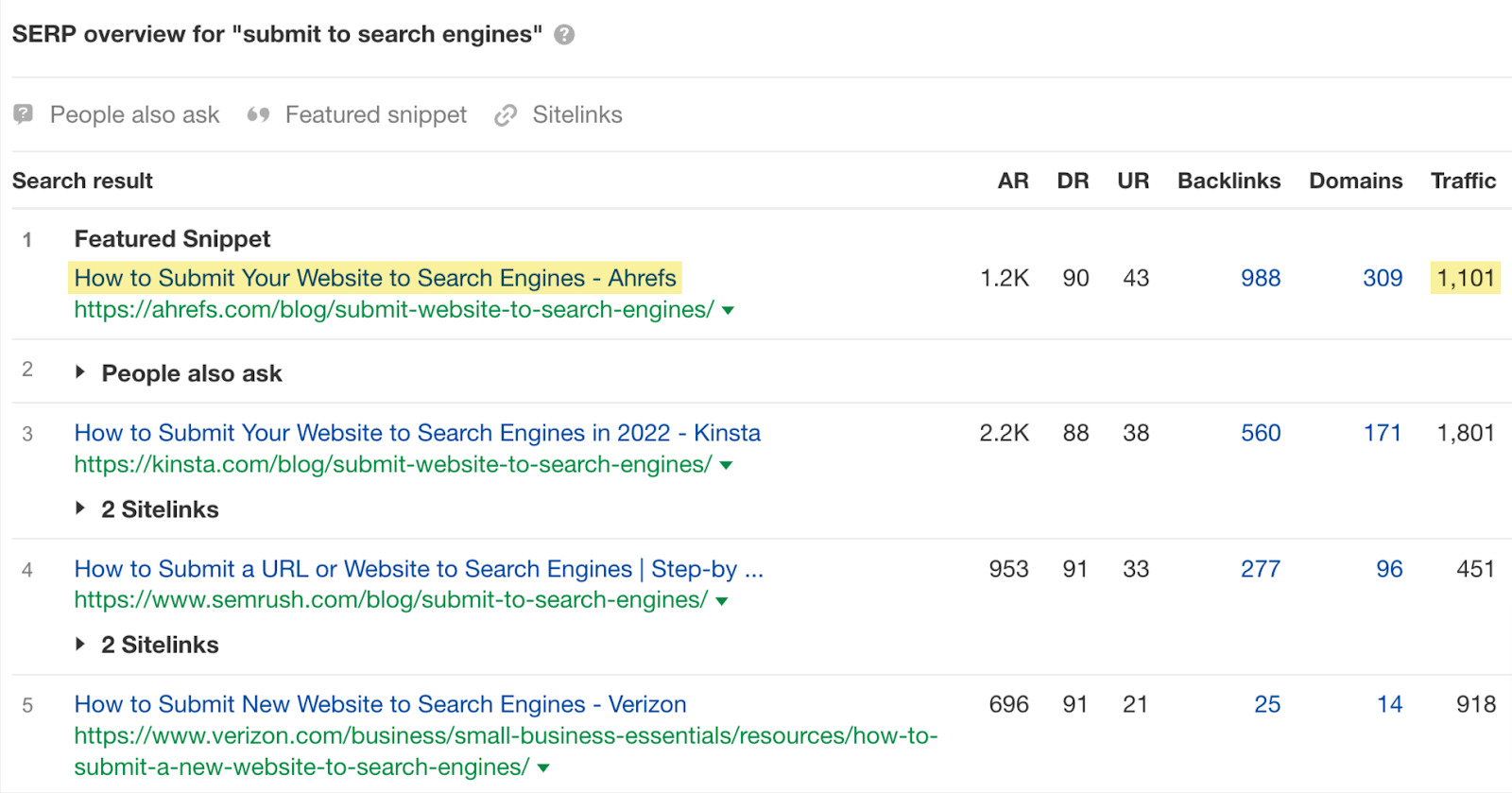
If you think that’s too much manual work, you can try an audience research tool like SparkToro. Just plug in topics your target audience frequently talks about to discover related topics and hashtags (among many other things).

On top of topic ideas, SparkToro can also help you with identifying their demographics and discovering what media your target audience consumes.
Survey your audience
Try the obvious—just ask your audience what type of content will make their life easier.
If you already have some blog/newsletter subscribers on board, this step is as easy as preparing a questionnaire and sending it. Alternatively, you can display a short questionnaire on your site.
But if you’re just starting out, you can use an agile market research software like SurveyMonkey to get your questionnaire in front of the right eyes.
Here are a few questions you can ask:
- What would you like to learn about on this blog?
- What’s the biggest priority in your job?
- In the last months, what was your biggest challenge?
- Do you plan on buying our product in the near future?
- How did you discover our blog?
- What’s your favorite source of information about ___?
And that’s about it when it comes to the “traditional” approach to content mapping. Here’s what we, at Ahrefs, do differently and why we do it that way.
The traditional way of content mapping matches content to a single stage of the funnel. But that one-to-one match isn’t always the case. So we use a different approach that helps us create product-led content that brings over 273K visits from search to our blog every month.

A little bit of theory
The thing is that a single article can serve various purposes. It can attract a potential customer and help to retain an existing customer.
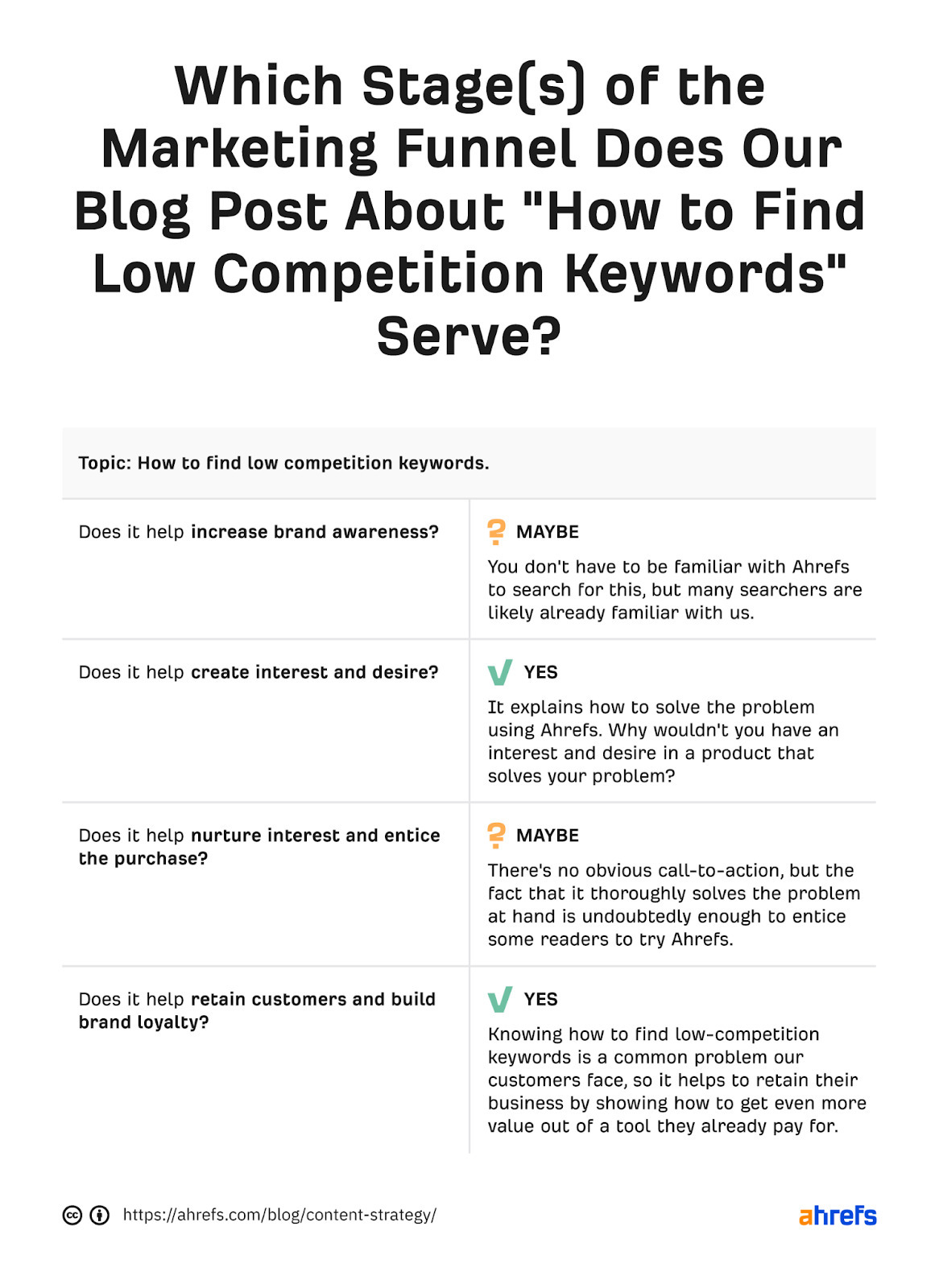
Moreover, in some cases, a single article can take the user down the entire funnel—from learning about a solution to purchasing the solution.
Let’s take our guide on how to rank higher on Google as an example. In six easy steps, it explains how to improve rankings of underperforming keywords and get more traffic as a result.
So let’s say someone Googles “how to rank higher on google.” That person is pretty much right at the top of the funnel because they’re aware of their problem but don’t know the solution yet. They may not have heard of Ahrefs and may have zero knowledge of SEO.
Being at the first stage of the funnel, they come across our guide. As the guide walks them through the process, it may also walk them through the entire funnel. They learn the solution (SEO) and learn that they need a tool like Ahrefs to implement the solution.
Besides, ask yourself this: Can you remember the last time branded content made you buy something? Was it one or more content pieces? Was your “buyer journey” linear or more complex? You may find that the map is not the territory.
The “business potential” framework
Because it seems that the models of the buyer’s journey aren’t always useful, we map content based on a scale of how crucial our product is in solving a given problem.
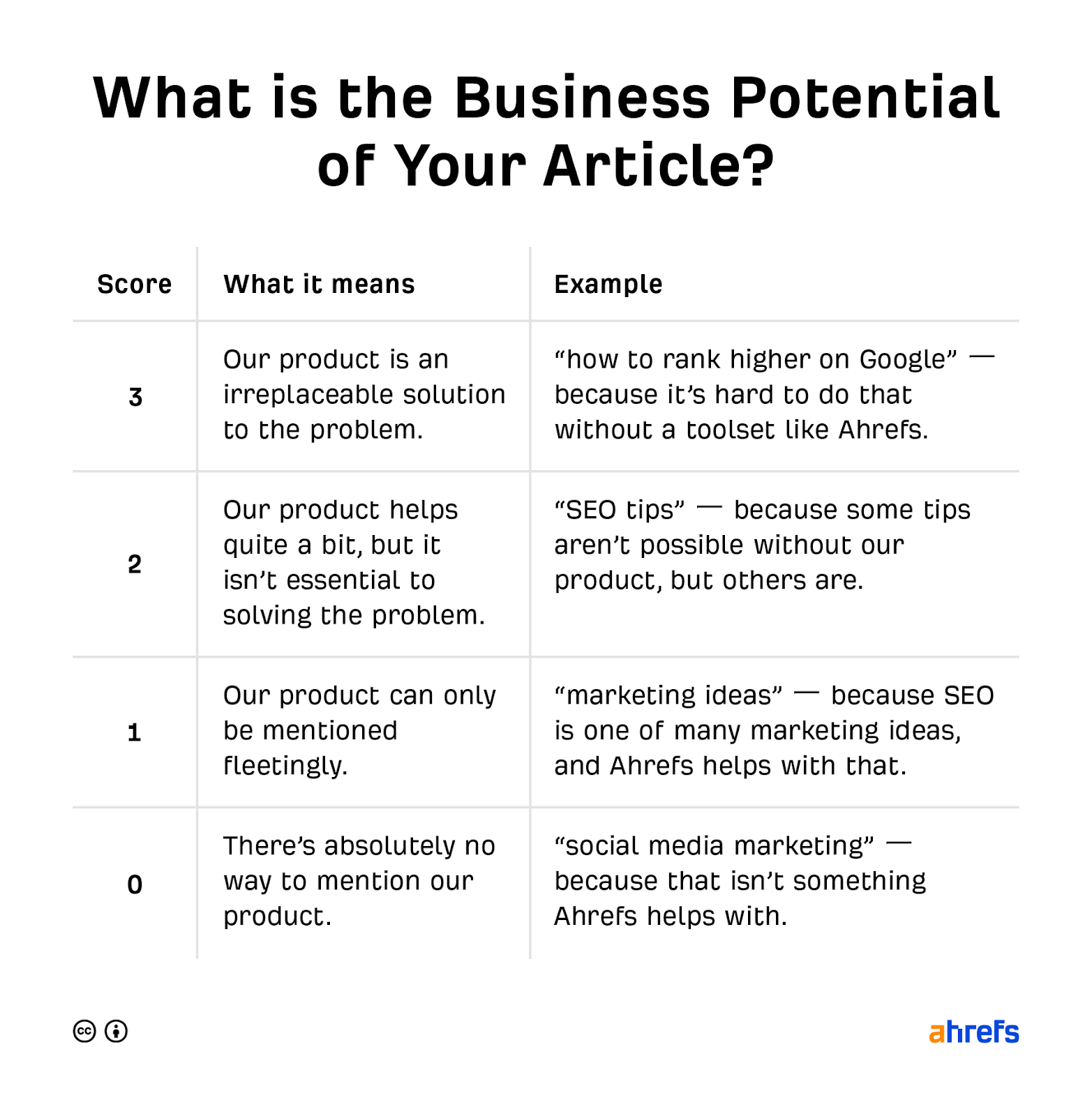
Let’s look at the business potential (BP) scale in detail and see some examples for each of the scores. If you want to dive deeper into this framework, you can skim through the articles below to see how our product is featured (or why it can’t be featured).
So if you want to create a content map with the use of our framework, it’s a really simple one—just the topic and its BP score.
Additionally, you can complement that with some SEO metrics (like traffic potential) if search engines are an essential marketing channel to you. So it can look something like this:
| Topic | Business potential | Organic traffic potential |
|---|---|---|
| 13 Best Marketing Blogs to Follow (For Marketers of All Levels) | 0 | 300 |
| Marketing Objectives: How to Set Them Right (With Examples) | 1 | 1200 |
| ‘Not Provided’ in Google Analytics: How to Reclaim Your Keyword Data | 2 | 800 |
| What Is SEO Content? How to Write Content That Ranks | 3 | 900 |
That said, there are still some similarities between our model and the traditional model. For example, we also use buyer personas. We don’t use them to “customize” every topic, though. We use them to understand who we are talking to so we can align the style and depth of the content.
For example, we’re trying to avoid marketing jargon, as we’re not targeting our content to marketing academics but rather marketing practitioners who are not always experts in this field.
You will find these tools helpful in creating and populating your content map:
- Ahrefs – SEO tools like ours are indispensable if you want to learn what people look for online, how often, and what words they use in their searches.
- Google Sheets – This is for using our content mapping template.
- Diagramming tool – Some examples include Lucidchart or MindMeister, which are great for creating buyer’s journey diagrams/maps. This is an additional (and harder) step you can take in content mapping. Do this if you want to better understand and/or visualize the buyer’s journey in your particular case.
- Survey tool – Tools such as Google Forms, SurveyMonkey, or Survicate can be used for getting feedback about your content.
- Audience research tool – Try SparkToro or Brandwatch for finding the topics that make your audience tick.
Final thoughts
Let’s complete this guide by discussing some advantages and disadvantages of these two content mapping methods:
| Traditional content mapping | Ahrefs’ content mapping | ||
|---|---|---|---|
| Pros | Cons | Pros | Cons |
| Customizes content for specific personas | Too “square” buckets | Easy to implement | Can lead to missed opportunities where product-led content can’t be applied |
| Easier to spot gaps in the buyer’s journey | Can become too complicated (too time consuming) | Enhances product marketing | Frequent product placement can lead to readers’ fatigue in owned marketing channels |
| Can be used for all content formats and channels | Uses a simplified model of user behavior | Best for blogging, video blogging and, generally, longer content formats |
So can we take the best of both worlds and create a hybrid? I think so. One way is to insert the business score into the stages of the buyer’s journey.
For example, you can require a score of 2 or 3 for content designed to entice people to make a purchase. Topics with scores 0 and 1 are OK as long as they are either in the interest, desire, or retain stages.
Whether that hybrid model works well enough is a conclusion I’ll leave you to make.
What’s next after mapping content? Try our resources on content marketing to learn things like content strategy, content creation, promotion, and repurposing.
Got questions or comments? Ping me on Twitter.
Source: ahrefs.com, originally published on 2022-04-26 03:47:27
Connect with B2 Web Studios
Get B2 news, tips and the latest trends on web, mobile and digital marketing
- Appleton/Green Bay (HQ): (920) 358-0305
- Las Vegas, NV (Satellite): (702) 659-7809
- Email Us: [email protected]

© Copyright 2002 – 2022 B2 Web Studios, a division of B2 Computing LLC. All rights reserved. All logos trademarks of their respective owners. Privacy Policy

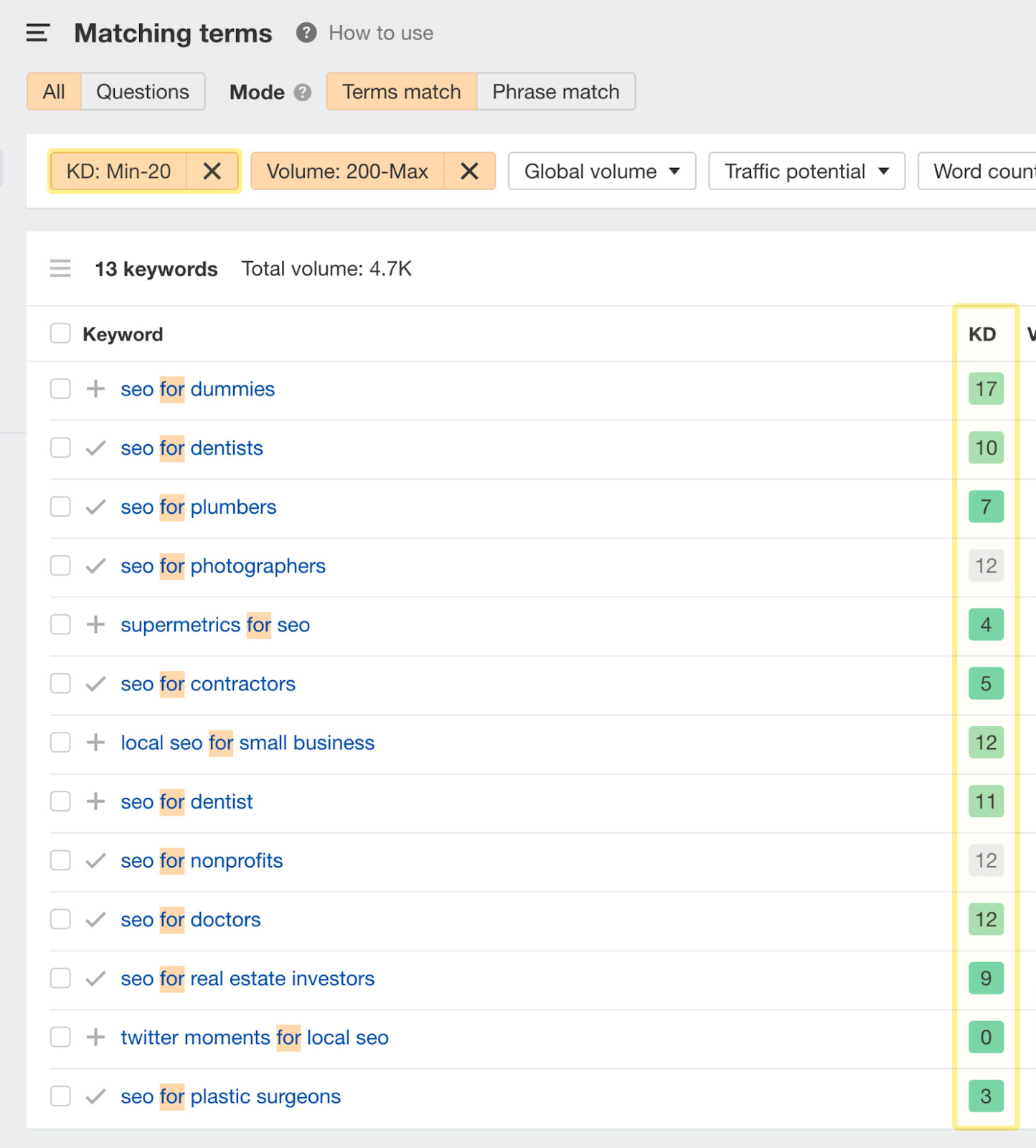

![How to Successfully Use Social Media: A Small Business Guide for Beginners [Infographic]](https://b2webstudios.com/storage/2023/02/How-to-Successfully-Use-Social-Media-A-Small-Business-Guide-85x70.jpg)



![How to Successfully Use Social Media: A Small Business Guide for Beginners [Infographic]](https://b2webstudios.com/storage/2023/02/How-to-Successfully-Use-Social-Media-A-Small-Business-Guide-300x169.jpg)


Recent Comments